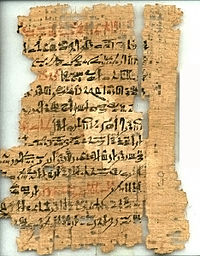Loyalist Teaching

The Loyalist Teaching, or The Loyalist Instructions, is an
Sources
The first half of The Loyalist Teaching is found on a Twelfth-dynasty
Content

The full text of The Loyalist Teaching comprises approximately 145 verses.
Richard B. Parkinson—a
References
- ^ a b Cairo CG 20538.
- ^ Verhoeven 2009
- ^ a b c Simpson (1972), p. 198; Parkinson (2002), pp. 318-319.
- ^ a b c d Parkinson (2002), pp. 318-319.
- ^ Simpson (1972), p. 198.
- ^ a b Weeks (1999), p. 166.
- ^ a b Simpson (1972), pp. 7-8.
- ^ Posener (1976), p. 14; Simpson (1991), p. 337; Fischer-Elfert (1999), p. 418-20.
- ^ Vernus (1990), p. 185.
Bibliography
- Fischer-Elfert, Hans-Werner (1999). Die Lehre eines Mannes für seinen Sohn: eine Etappe auf dem "Gottesweg" des loyalen und solidarischen Beamten der frühen 12. Dynastie. Ägyptologische Abhandlungen 60. Harrassowitz (Wiesbaden). ISBN 3-447-03919-1.
- Parkinson, Richard B. (2002). Poetry and Culture in Middle Kingdom Egypt: A Dark Side to Perfection. London: Continuum. ISBN 0-8264-5637-5.
- Posener, Georges. (1976). L'Enseignement loyaliste: sagesse égyptienne du Moyen Empire. Geneva: Librairie Droz.
- Simpson, William Kelly. (1972). The Literature of Ancient Egypt: An Anthology of Stories, Instructions, and Poetry. Edited by William Kelly Simpson. Translations by R.O. Faulkner, Edward F. Wente, Jr., and William Kelly Simpson. New Haven and London: Yale University Press. ISBN 0-300-01482-1.
- Simpson, William Kelly. (1991). "Mentuhotep, Vizier of Sesostris I, Patron of Art and Architecture," MDAIK 47: 331-40.
- Verhoeven, Ursula (2009). Von der „Loyalistischen Lehre" zur „Lehre des Kairsu", in: Zeitschrift für ägyptische Sprache und Altertumskunde 136 (2009), 87-98. (online: http://archiv.ub.uni-heidelberg.de/propylaeumdok/volltexte/2012/1353/pdf/Verhoeven_Von_der_Loyalistischen_Lehre_2009.pdf).
- Vernus, Pascal. (1990). Future at Issue, Tense, Mood and Aspect in Middle Egyptian: Studies in Syntax and Semantics. Oxford: Aris & Phillips Ltd. ISBN 978-0-85668-587-3.
- Weeks, Stuart. (1999). Early Israelite Wisdom. Oxford: Oxford University Press. ISBN 0-19-826750-9.
External links
- The Sehetepibre Stela: The Loyalist Instructions (with translations by William Kelly Simpson and James Henry Breasted)
